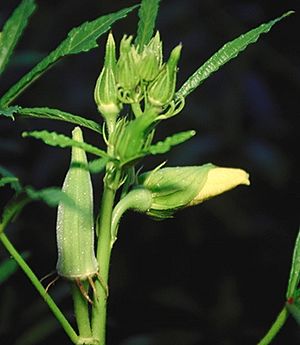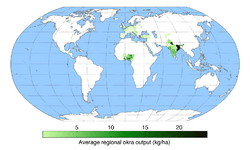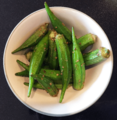Okra facts for kids
Quick facts for kids Okra |
|
|---|---|
 |
|
| Okra flower bud and immature seed pod | |
| Scientific classification | |
| Kingdom: | |
| Division: | |
| Class: | |
| Order: | |
| Family: | |
| Genus: |
Abelmoschus
|
| Species: |
A. esculentus
|
| Binomial name | |
| Abelmoschus esculentus |
|
 |
|
| Worldwide okra production | |
| Synonyms | |
|
Hibiscus esculentus L. |
|
Okra (Abelmoschus esculentus), also known as lady's fingers or gumbo, is a flowering plant. It belongs to the mallow family, which includes plants like cotton and hibiscus. People grow okra for its tasty green seed pods. These pods are picked when they are young and are often used in salads and soups.
Okra as Food
When you cook okra pods, they can get a bit "gooey" or "slimy." This is because they contain a special substance called mucilage. This mucilage is good for you because it has soluble fiber. You can cook okra, pickle it, eat it raw, or add it to salads. Okra can also help people in places where it's hard to find enough food.
Okra Nutrition
Raw okra is mostly water (about 90%). It also has some protein (2%) and carbohydrates (7%). It has almost no fat. If you eat 100 grams of raw okra, you get a lot of dietary fiber, vitamin C, and vitamin K. It also has good amounts of thiamin, folate, and magnesium.
Leaves and Seeds
You can cook young okra leaves, just like you would cook the greens from beets or dandelions. Some people also enjoy eating the leaves raw in salads.
Okra seeds can be roasted and ground up to make a drink that tastes like coffee. This drink does not have caffeine. During the American Civil War in 1861, it was hard to get coffee. People found that one acre of okra could grow enough seeds to give a large farm all the coffee it needed. It was said to be just as good as coffee from Rio.
Okra seeds can also be pressed to make a greenish-yellow oil. This oil tastes and smells nice. It is high in healthy unsaturated fats, like oleic acid and linoleic acid. Some types of okra seeds have about 40% oil. In one test, okra oil produced 794 kilograms per hectare. Only sunflower oil had a higher yield. A study in 2009 found that okra oil could even be used as a biofuel.
Other Uses for Okra
Okra plants have other uses too. The strong fibers from the stem, called bast fiber, can be used in industry. They can help make stronger plastic materials. The mucilage from the okra plant can also be used to clean dirty water. It helps to remove cloudiness from waste water.
Images for kids
See also
 In Spanish: Okra para niños
In Spanish: Okra para niños











